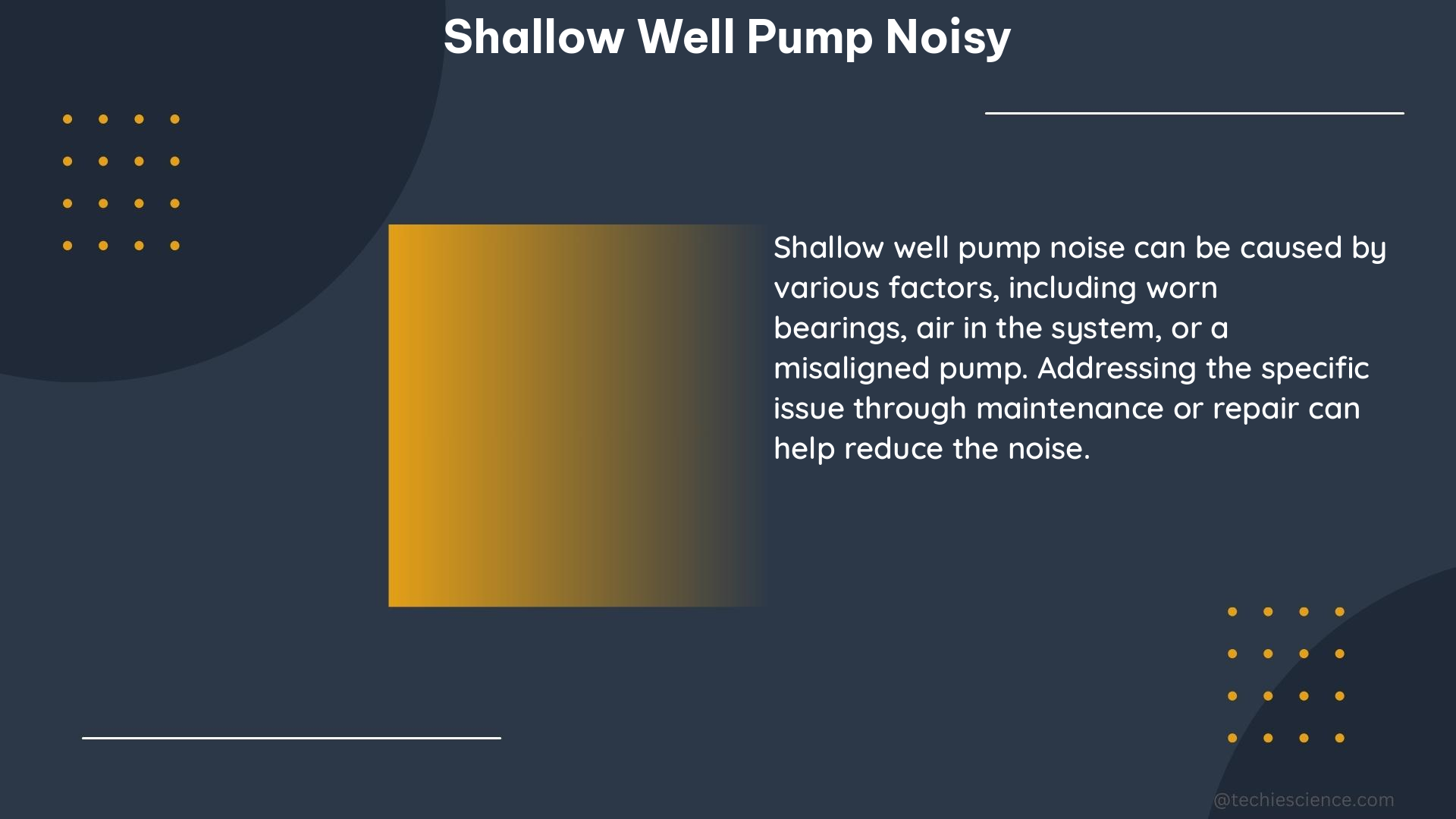Shallow well pumps are essential components in many residential and agricultural water systems, providing a reliable source of water from underground aquifers. However, these pumps can sometimes become noisy, which can be a sign of underlying issues that require attention. In this comprehensive guide, we will delve into the common causes of shallow well pump noise and provide detailed steps to diagnose and remedy the problem.
Causes of Shallow Well Pump Noise
Shallow well pumps can become noisy due to a variety of reasons, including:
- Winding Problems: The electric motor that powers the pump can develop issues with its windings, leading to increased vibration and noise.
- Bearing Wear: Over time, the bearings that support the pump’s shaft can wear down, causing increased friction and noise.
- Cavitation: Cavitation is the formation of vapor cavities in the liquid being pumped, which can occur when the pump is not getting enough water, the suction line is restricted, or the foot valve is covered in mud. This can cause a gravel-like noise or vibration in the pump.
In the case of a noisy Grundfos shallow well jet pump, the pump may sound like it is re-priming itself each time it kicks on. This can be caused by a variety of issues, including wiring problems or issues with the foot valve or check valve.
Troubleshooting a Noisy Shallow Well Pump

When troubleshooting a noisy shallow well pump, it is important to follow a systematic approach to identify the root cause of the issue. Here are the steps to take:
-
Check for Leaks: Inspect the suction side of the pump for any leaks, as this can cause the pump to suck in air, leading to cavitation and noise. Also, check the pressure side for any leaks, as this can cause water to leak out and affect the pump’s performance.
-
Assess the Water Level: Ensure that the water level in the well is sufficient to provide the pump with adequate suction. If the water level is too low, the pump may be drawing in air, leading to cavitation and noise.
-
Inspect the Suction Line: Check the suction line for any restrictions, such as kinks, clogs, or a too-small diameter. Friction losses in the suction line can contribute to cavitation and noise.
-
Examine the Foot Valve: If the pump is equipped with a foot valve, remove the drop pipe and inspect the valve for proper function and cleanliness. A malfunctioning or clogged foot valve can cause the pump to lose its prime, leading to cavitation and noise.
-
Measure the Pump’s Performance: Use a pressure gauge to measure the pump’s discharge pressure and a flow meter to measure the pump’s output. Compare these readings to the pump’s specifications to identify any performance issues that may be contributing to the noise.
-
Inspect the Pump’s Bearings: Regularly greasing the pump’s bearings can help prevent wear and noise. If the bearings are worn, they may need to be replaced.
-
Check the Wiring and Electrical Components: Ensure that the pump’s wiring and electrical components, such as the capacitor and contactor, are in good working order. Issues with these components can lead to increased vibration and noise.
Remedying a Noisy Shallow Well Pump
Once the root cause of the noise has been identified, you can take the appropriate steps to remedy the issue. Here are some common solutions:
- Resolving Cavitation: If cavitation is the issue, you can try the following:
- Increase the water level in the well by lowering the pump’s intake depth or adding a water storage tank.
- Ensure that the suction line is the correct size and free of restrictions.
-
Clean or replace the foot valve to ensure proper function.
-
Addressing Bearing Wear: If the bearings are worn, you will need to replace them. This may require disassembling the pump and replacing the bearings with new ones that match the pump’s specifications.
-
Fixing Winding Issues: If the motor’s windings are the source of the noise, you may need to have the motor rewound or replaced by a qualified technician.
-
Resolving Electrical Problems: If the issue is related to the pump’s wiring or electrical components, you may need to have a licensed electrician inspect and repair the system.
-
Performing Regular Maintenance: To prevent future noise issues, it is important to regularly maintain the shallow well pump. This includes:
- Greasing the bearings according to the manufacturer’s recommendations.
- Inspecting the suction line and foot valve for any issues.
- Monitoring the pump’s performance and addressing any changes.
By following these steps, you can effectively troubleshoot and remedy a noisy shallow well pump, ensuring that your water system continues to operate smoothly and efficiently.
References:
- My shallow well pump is making a much higher pitched noise
- Troubleshooting a Noisy Shallow Well Pump
- Diagnosing and Fixing a Noisy Shallow Well Pump

The lambdageeks.com Core SME Team is a group of experienced subject matter experts from diverse scientific and technical fields including Physics, Chemistry, Technology,Electronics & Electrical Engineering, Automotive, Mechanical Engineering. Our team collaborates to create high-quality, well-researched articles on a wide range of science and technology topics for the lambdageeks.com website.
All Our Senior SME are having more than 7 Years of experience in the respective fields . They are either Working Industry Professionals or assocaited With different Universities. Refer Our Authors Page to get to know About our Core SMEs.